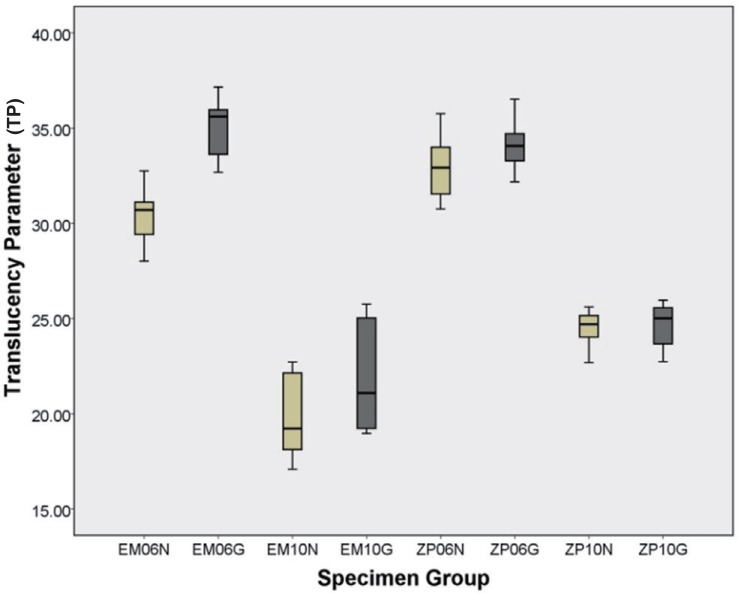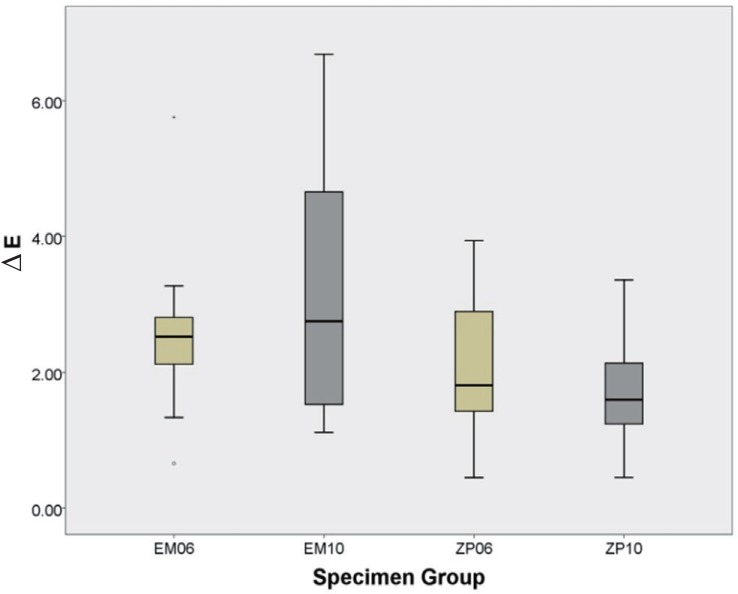1. Ryu SY, Lim JH, Cho IH. A study on the color stability of porcelain for porcelain fused to metal crown. J Korean Acad Prosthodont. 2000; 38:73–84.
2. Joiner A. Tooth colour: a review of the literature. J Dent. 2004; 32(Suppl 1):3–12.

3. Al Ben Ali A, Kang K, Finkelman MD, Zandparsa R, Hirayama H. The effect of variations in translucency and background on color differences in CAD/CAM lithium disilicate glass ceramics. J Prosthodont. 2014; 23:213–220. PMID:
23889762.

4. Barizon KT, Bergeron C, Vargas MA, Qian F, Cobb DS, Gratton DG, Geraldeli S. Ceramic materials for porcelain veneers: part II. Effect of material, shade, and thickness on translucency. J Prosthet Dent. 2014; 112:864–870. PMID:
24969410.

5. Yilmaz C, Korkmaz T, Demirköprülü H, Ergün G, Ozkan Y. Color stability of glazed and polished dental porcelains. J Prosthodont. 2008; 17:20–24. PMID:
17971115.
6. Wiskott HWA. Fixed prosthodontics: principles and clinics. London, UK: Quintessence publishing;2011. p. 670–671.
7. Choi BB, Woo YH, Kim HS. Contemporary fixed prosthodontics. 3rd ed. Seoul, Korea: Jisung Publishing;2003. p. 645.
8. Yılmaz K, Gonuldas F, Ozturk C. The effect of repeated firings on the color change of dental ceramics using different glazing methods. J Adv Prosthodont. 2014; 6:427–433. PMID:
25551001.

9. Obregon A, Goodkind RJ, Schwabacher WB. Effects of opaque and porcelain surface texture on the color of ceramometal restorations. J Prosthet Dent. 1981; 46:330–340. PMID:
7021809.

10. Heffernan MJ, Aquilino SA, Diaz-Arnold AM, Haselton DR, Stanford CM, Vargas MA. Relative translucency of six all-ceramic systems. Part II: core and veneer materials. J Prosthet Dent. 2002; 88:10–15. PMID:
12239473.

11. Chu FC, Chow TW, Chai J. Contrast ratios and masking ability of three types of ceramic veneers. J Prosthet Dent. 2007; 98:359–364. PMID:
18021824.

12. Spear F, Holloway J. Which all-ceramic system is optimal for anterior esthetics? J Am Dent Assoc. 2008; 139(Suppl):19S–24S.

13. Kim SJ, Son HH, Cho BH, Lee IB, Um CM. Translucency and masking ability of various opaque-shade composite resins. J Dent. 2009; 37:102–107. PMID:
19028004.

14. Sinmazisik G, Demirbas B, Tarcin B. Influence of dentin and core porcelain thickness on the color of fully sintered zirconia ceramic restorations. J Prosthet Dent. 2014; 111:142–149. PMID:
24189117.

15. Kim SJ, Kahm SH. Translucency of ceramic veneers on glazing effect. J Korean Acad Prosthodont. 2015; 53:138–143.

16. Kahm SH, Lee BJ, Seo MS, Kim SJ. Color difference of lithium disilicate ceramic veneer on glazing effect. Oral Biol Res. 2016; 40:124–128.
17. Kahm SH, Heo UC, Kim SJ. Color change of lithium disilicate ceramic veneer on different thicknesses with and without glazing. Oral Biol Res. 2017; 41:8–14.

18. British standard specification for dental porcelains for jacket crowns. BS5612. London, UK: British Standard Institution;1978.
19. Johnston WM, Ma T, Kienle BH. Translucency parameter of colorants for maxillofacial prostheses. Int J Prosthodont. 1995; 8:79–86. PMID:
7710631.
20. Santos MO, do Amaral FL, França FM, Basting RT. Influence of translucence/opacity and shade in the flexural strength of lithium disilicate ceramics. J Conserv Dent. 2015; 18:394–398. PMID:
26430304.

21. Bagis B, Turgut S. Optical properties of current ceramics systems for laminate veneers. J Dent. 2013; 41(Suppl 3):e24–e30.

22. Wang H, Xiong F, Zhenhua L. Influence of varied surface texture of dentin porcelain on optical properties of porcelain specimens. J Prosthet Dent. 2011; 105:242–248. PMID:
21458649.

23. Awad D, Stawarczyk B, Liebermann A, Ilie N. Translucency of esthetic dental restorative CAD/CAM materials and composite resins with respect to thickness and surface roughness. J Prosthet Dent. 2015; 113:534–540. PMID:
25749093.

24. Jeong ID, Bae SY, Kim DY, Kim JH, Kim WC. Translucency of zirconia-based pressable ceramics with different core and veneer thicknesses. J Prosthet Dent. 2016; 115:768–772. PMID:
26794702.

25. Kurtulmus-Yilmaz S, Ulusoy M. Comparison of the translucency of shaded zirconia all-ceramic systems. J Adv Prosthodont. 2014; 6:415–422. PMID:
25352964.

26. Kuehni RG, Marcus RT. An experiment in visual scaling of small color differences. Color Res Appl. 1979; 4:83–91.
27. Ragain JC, Johnston WM. Color acceptance of direct dental restorative materials by human observers. Color Res Appl. 2000; 25:278–285.

28. Ruyter IE, Nilner K, Moller B. Color stability of dental composite resin materials for crown and bridge veneers. Dent Mater. 1987; 3:246–251. PMID:
3479360.

29. Johnston WM, Kao EC. ssessment of appearance match by visual observation and clinical colorimetry. J Dent Res. 1989; 68:819–822. PMID:
2715476.
30. Turgut S, Bagis B, Ayaz EA, Korkmaz FM, Ulusoy KU, Bagis YH. How will surface treatments affect the translucency of porcelain laminate veneers? J Adv Prosthodont. 2014; 6:8–13. PMID:
24605200.












 PDF
PDF ePub
ePub Citation
Citation Print
Print




 XML Download
XML Download